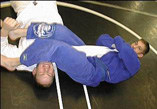Brazilian Jiu-Jitsu
|
Where does Brazilian Jiu-Jitsu come from?The art began with Mitsuyo Maeda (aka Conde Koma, or Count Coma in English), an expert Japanese judoka and member of the Kodokan. Maeda was one of five of the Kodokan's top groundwork experts that judo's founder Kano Jigoro sent overseas to spread his art to the world. Maeda left Japan in 1904 and visited a number of countries giving "jiu-do" demonstrations and accepting challenges from wrestlers, boxers, savate fighters and various other martial artists before eventually arriving in Brazil on November 14, 1914.
Jujutsu, as with its parent art of judo, is known as more than just a system of fighting. Since its inception in 1882, judo was separated from older systems of Japanese jujutsu. This was more than just Kano's ambition to clearly individualize his art: to Kano, judo wasn't solely a martial art: it was also a sport; a method for promoting physical fitness and building character in young people; and, ultimately, a way (Do) of life. It is often claimed that BJJ is a development of traditional Japanese jujutsu, not judo, and that Maeda was a jujutsuka. However, Maeda never trained in jujutsu. He first trained in sumo as a teenager, and after the interest generated by stories about the success of judo at contests between judo and jujutsu that were occurring at the time, he changed from sumo to judo, becoming a student of Kano's Kodokan judo. He was promoted to 7th dan in Kodokan judo the day before he died in 1941. Maeda met an influential businessman named Gastão Gracie who helped him get established. In 1916, his 14 year-old son Carlos Gracie watched a demonstration by Maeda at the Teatro da Paz (Theatre of Peace) and decided to learn the art. Maeda accepted Carlos as a student, and Carlos went on to become a great exponent of the art and ultimately, with his younger brother Hélio Gracie became the founder of Gracie Jiu-Jitsu, modern Brazilian Jiu-Jitsu. In 1921, Gastão Gracie and his family moved to Rio de Janeiro. Carlos, then 17 years old, passed Maeda's teachings on to his brothers Osvaldo, Gastão and Jorge. Hélio was too young and sick at that time to learn the art, and due to medical imposition was prohibited to take part in the training sessions. Despite that, Hélio learned from watching his brothers. He eventually overcame his health problems and is now considered by many as the founder of Brazilian Jiu-Jitsu (though others, such as Carlson Gracie, have pointed to Carlos as the founder of the art). Hélio competed in several submission judo competitions which mostly ended in a draw. One defeat (in Brazil in 1951) was by visiting Japanese judoka Masahiko Kimura, whose surname the Gracies gave to the arm lock used to defeat Hélio. The Gracie family continued to develop the system throughout the 20th century, often fighting vale tudo matches (precursors to modern MMA), during which it increased its focus on ground fighting and refined its techniques. Today, the main difference between the BJJ styles is, between traditional Gracie Jiu-Jitsu's emphasis on self-defense, and Sport Brazilian Jiu-Jitsu's orientation towards competition. There is a large commonality of techniques between the two.
|



 What is Brazilian Jiu-Jitsu?
What is Brazilian Jiu-Jitsu? 